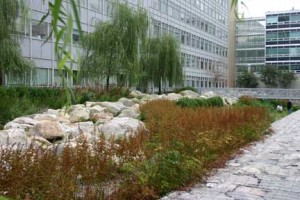Pocket Gardens: Find Your Own Green Oasis
-
-
slice.mit.edu
- 1
Filed Under
Recommended

Cozy spots to relax and revive are rare enough on MIT’s campus—so there’s a map of Pocket Gardens to guide community members and visitors to the 21 small gardens tucked around campus.
Most of these pocket gardens are open to anyone walking through campus to enjoy—and to learn about the plantings. Ever wonder what are those tall skinny trees, nested in a sea of grasses outside the Zesiger Sports and Fitness Center? The plant list for the Building 35 garden reveals they are Liquidambar ‘Slender Silhousette’ (Sweet Gum).

The Stata Swale is in a prominent location behind the famously wonky shape of the Ray and Maria Stata Center for Computer, Information, and Intelligence Sciences completed in 2004. The swale, a particularly hard-working garden, is one of the building’s sustainable design elements. Half the site is drained to the biofiltration swale, which was designed to capture and biologically degrade pollutants carried by stormwater runoff, and it serves several nearby buildings. The plants include Salix babylonica (Weeping Willow), Polystichum acrostichoides (Christmas Fern), and Iris versicolor (Harlequin Blueflag).

Some gardens are courtyards inside buildings, such as the Lipchitz Courtyard inside Building 14, adjacent to Hayden Library. The name comes from three sculptures by 20th century Cubist artist Jacques Lipchitz, which were donated by his wife in honor of a past MIT presiden. From the Department of Facilities description, you can read about the donation and the plants.
True garden lovers can see the photo-by-photo documentation of the 2006 transplantation of two mighty oaks from the Dibner Building, which was being demolished, to the E32 site.
The MIT Grounds Services maintain the gardens and offer periodic garden tours.








Comments
Claire Calcagno
Thu, 10/02/2014 12:16pm
What a wonderful post! I love finding special corners around the campus. I especially enjoyed seeing the pictures of the oaks being transplanted from the Dibner Building (where I once had a post-doc office...) to a new home. Thank you.